The Indian Experience in the South: Georgia via Guntur
Many may not remember that Denzel Washington played the role of Steven Biko in Richard Attenborough’s Cry Freedom and was a rising star when he was cast in the role of Demetrius, a self-employed carpet cleaner, in the small-budget movie Mississippi Masala released in 1991. This movie, in which an African American man from Mississippi falls in love with an Indian woman and the family tensions that ensue, was one of the first tastes of the masala in the Indian American curry that the South got to experience. Almost twenty-five years later, there were two Indian Americans, or “Asian Indians” (as we are officially labeled by the U.S. Census Bureau) occupying governors’ mansions in southern states, and one could easily assume that there is a special relationship that binds those who began arriving in the United States in small numbers in the early nineteenth century and the Bible belt of southern states in the twenty-first century. The two governors, Bobby Jindal and Nikki Haley, have even been considered as potential presidential material, and so, surely, there must be some ingredient in the South that lends potency to the Indian presence in what has usually been considered hostile territory to many non-southerners.
Stories of the Indian immigrant to the United States are as varied and as complicated as the myriad strands of Hinduism, and most are packaged in some stereotype or the other, benign or simplistic, malign or mistaken. Adding to the confusion are contemporary academics who prefer to label Indians “South Asians” because India was divided by the British into India and Pakistan in 1947, and therefore the new India is not the old India, and the old India now includes Pakistan and Bangladesh. So, their reasoning is why not lump all Indians together in an abstract and synthetic “South Asia”? This, however, causes confusion to nonacademics, who don’t understand the differences between the “old” and “new” Indias. Any attempt therefore to present the “essence” of India is bound not only to be partial but also unsatisfactory. We can only offer slices of that complex whole and hope that the reader or viewer will be tempted to make their own travel arrangements and discover for themselves the serenity undergirding the tumultuous ideas and realities of India. It is in that spirit that I have chosen to profile the six people in this essay—not as representatives of India or the New South, but as windows that allow a peek into the old-new world.
The Indian story is complicated simply because India is an ancient land, and its modern inhabitants are citizens of the second most populous country in the world. Their home is the birthplace of Hinduism, Buddhism, Jainism, and Sikhism, and “South Asia” has the largest Muslim population in the world and is home to the majority of Hindus in the world. With about 2.5 percent of its population Christian, India has more Christians than there are people in Australia. To escape this complex and confusing tale, some Indians, born Hindu, converted to Catholicism. This enabled them to tell a simpler story of themselves embellished to appeal to their majority Christian constituency. Others, born Sikh, did the same and some now attend Christian churches. So, the United States is welcoming, it seems, if one is willing to both tell a simpler tale and make some major adjustments. And, if we are willing to remove the hyphen out of our identity tags, we can all become Americans, they say.
***
The first Indians who landed on the shores of the United States might have been brought here as slaves and, within a generation of the English setting up camp in Jamestown, there were English- and French-speaking Indian slaves, who had been “Christianized,” and who considered themselves a different class of slaves. How many of them survived, married, had children, and made a life for themselves, we don’t know, and few of the Indian American historians now doing research in U.S. universities seem to care to trace those stories. About 6,400 Punjabi Sikhs, landing on the West Coast, who were mostly male, illiterate, and unskilled laborers and agricultural workers, arrived between 1907 and 1909 before the authorities called a halt to their immigration, and locals harassed and tried to run them off. Many of them were persistent, however, and some of their descendants are now the biggest landowners in California.
Indian Americans are now considered the newest of immigrants, with the vast majority of us having been born outside of the United States, mostly in India but also having arrived from Britain, Africa, and the Caribbean. A Pew report shows that about 87 percent of Indian American adults were foreign-born and that only 56.2 percent of adults were U.S. citizens. I find many of these “newer” immigrants working for Aflac or TSYS in Columbus, Georgia, where most of them are “techies”—software engineers, designers, testers—many of whom arrived during and after the high-tech boom in the 1990s, and especially during the period leading up to the doomsday scare of Y2K. A large group of these “techies” were recruited to do the basic “debugging” of computers and computer systems to ensure that there would be none of the cyber-disasters imagined at the turn of the century.
Given that Indians came to the United States not to escape religious persecution, war, or natural disasters, but in search of a better education and a better life, and that most arrived here after the 1965 Immigration Act that allowed people from around the world to make their way to the United States, Indians are among the most highly educated immigrant or ethnic groups—one of the “model minorities.”
In this context, those who came to the United States during the high-tech boom in the 1990s, and later, have not gone through the challenges and experiences that Indian immigrants faced when they first began arriving in the 1960s: the struggle to understand American colloquialisms and the difficulty of being understood; the expensive, short, once-a-month international phone call home; the eager wait for letters and small packets from home; the pangs of loneliness walking across a bare campus during spring or Christmas breaks; the hankering for homemade food; the challenge of understanding American ways and attitudes; the hand-to-mouth existence of graduate students and the joys of graduating and finding a job that liberated one from the servitude of graduate assistantships. Not all graduate students lived frugally, however. Having arrived at the University of Southern Mississippi in 1985 to pursue a graduate degree in Mass Communication and offered a graduate assistantship of $4,500 from which I had to pay more than half toward tuition, I realized that most of us were in the same boat, except for some of the students who came from wealthy families, or who had some well-to-do relatives paying for a spacious apartment, or a couple both earning substantially more as research assistants in a polymer science or engineering department.
Recently, an Indian American professor of engineering, who teaches at Auburn University, was comparing his life with those of the new engineers and techies who are now arriving from India. These Indians are sent for short-term assignments and then stay on to find more lucrative offers by “expert-starved” U.S. corporations. “Our struggles,” my friend reminisced, included the difficult rites of passage through graduate school, followed by the twenty- or thirty-year slow progress toward middle-class stability through hard-fought tenure, scholarly publishing, difficult students, marriage in India, H1-B visas, green cards and citizenship paperwork, to the challenges of raising children in university towns. I remember that from Hattiesburg, Mississippi, some of us would pack ourselves into a car to do the hour-and-a-half journey to New Orleans to buy Indian groceries, and then travel six to eight hours to visit the Hindu temple in Houston. The expensive visits back home that happened once every two, three, or four years to attend a sister’s wedding or to mourn the death of a parent were filled with bittersweet melancholia, and whatever little goodies we could take home to distribute among relatives and friends was always done with some trepidation and self-consciousness. These newcomers, we both enviously observed, endured or suffered little of that: many of the techies have an undergraduate degree in engineering, with a couple of years’ experience in India, and within a few years, if they decide to stay and work in the United States, their lifestyles don’t just match but seem to exceed our own. He and I both wondered about our different “displacement” experiences and mulled over our karma. Sure, each of the million or so Indian arrivals at American airports over the past six decades have their unique stories to tell, and few may have the felicity to write and talk about their immigrant experiences. But they are there for the curious to mine and explore, as Khyati Joshi has done in her scholarly work, and as Bharati Mukherjee and Jhumpa Lahiri have done in their novels and short stories.
***
Many of the newcomers, depending on their engagement with the larger society, know little of the history and culture of the South. That Martin Luther King Jr. invoked Mahatma Gandhi to help him shape the black response to white racism, police brutality, and political chicanery barely registers on new Indian Americans, and that he traveled to India in 1959 as a pilgrim in search of the holy grail of nonviolence and peaceful protest is but rarely discussed among us. In fact, very few Indian historians have explored King’s remarkable visit to India.
Of the two million or so Indians living in the United States today only about 50 percent are Hindu, although they make up 80 percent of the Indian population. And while only about 2.5 percent of the Indian population is Christian they constitute about 18 percent of the immigrant population. This might authenticate or support the claim by many that the United States is a Christian country. That the experience of Indian Christians in the United States is qualitatively different from the experience of other Indian Americans is noted by Khyati Joshi in her book, New Roots in America’s Sacred Ground, when she observes that, “Christian research participants exhibit a qualitatively different set of experiences and responses in their relations with the dominant American culture” (46). In that context, it is equally important to note another observation she makes of Indian American religious groups: “Hindu research participants have a different construction of Indianness from that of the Sikh, Muslim, and Christian research participants” (46), which we can assume is because Hindus are a majority in India, while Sikhs, Muslims, and Christians (minorities in India) find a release from the constraints of that minority status here in the United States, with Christians identifying and acknowledging their newfound majority status here.
***
The connection between India and the United States has other dimensions as well, for example, in the area of spirituality, meditation, yoga, and philosophy. In fact, Philip Goldberg, in American Veda, chronicles the history of the American interest in and engagement with the most profound and beautiful of India’s contributions to the world: yoga, meditation, and spirituality. In the foreword to Goldberg’s book, Huston Smith writes, “Early translations of Vedic texts found their way to America in the opening decades of the country’s existence and influenced Jefferson, Adams, Emerson, and Thoreau . . . Vedanta quietly surfaces in the daily lives of Americans. Yoga, karma, meditation, enlightenment are now household words” (xiv–xv).
Before Swami Vivekananda, a young man, barely thirty, came to address the first World’s Parliament of Religions in Chicago in 1893, the likes of Thoreau and Emerson had already been seduced by the beauty and profundity of Hindu thought. Thus, when Vivekananda, who made his way to the city through a circuitous two-month journey via China, Japan, and Canada arrived in Chicago, six weeks before the inauguration of the conference, we already had some of the great American minds mesmerized by what India had to offer. Vivekananda stayed on for four years, founding the Vedanta Society in New York City in 1894, as well as traveling to Britain in 1895 and 1896. He captivated some of the best minds in the West, including the famous physicist Nikola Tesla, and the philosopher William James at Harvard, who offered the “Swami” a faculty position, which Vivekananda declined. Unfortunately, the farthest south that Vivekananda traveled was to Memphis, Tennessee, where he stayed from January 13 to 22, 1894. Hailed as the “greatest figure in the Parliament of Religions” by the New York Herald, he was also treated with hostility in some towns, where “things were thrown at him.”
Can we imagine what might have been his fate if Vivekananda were to have been invited to visit Jackson, Mississippi, or Atlanta, Georgia? Yoga and meditation groups can now be found in any town in any part of the United States, but there is also deep skepticism if not hostility to anything Hindu. Rev. Pat Robertson has even labeled Hindus “devil worshipers.” But water shall carve and shape stones, and we now find an eighteen-foot-tall image of Lord Shiva installed in a beautiful temple in the hills of southeastern Tennessee by the Isha Foundation; a grand, shimmering marble palace of a temple built in Atlanta—the Swaminarayan Temple; and the Art of Living Foundation retreat and health center in Boone, North Carolina. Some 80,000 Indian Americans make their home in the metro-Atlanta region, and they have a half dozen temples, large and small, that they gather in on weekends and on religious holidays, to bow and pray and conduct rituals, simple or profound, by trained priests or amateur house-holders.
***
It is difficult to stereotype Indian Americans though many have tried, including Hollywood. It seems strange that Hollywood writers cannot help but pigeonhole Indians as mostly petty shopkeepers, gas station and motel owners, or the occasional “exotic” “maharajas” who improbably feast on “eye-ball soup,” as depicted in the movie Indiana Jones and the Temple of Doom. But the times are changing and we now get a classic Hollywood sleight-of-hand with a character named Vincent Kapoor in The Martian. The name “Venkat Kapoor,” found in the book on which the movie is based, is itself improbable because Venkat is a South Indian name and Kapoor is mostly a Punjabi/North Indian family/last name, and when scouring any telephone book in any city in India you will not find one Venkat Kapoor. But America is chameleonlike and there are new roles for the new Indian immigrants: the Aziz Ansaris, the Aasif Mandvis, the Kal Penns, the Kunal Nayyars, the Hari Kondabolus and the Mindy Kalings who have begun to reshape the American perception of the Indian.
For example, Aziz Ansari, who grew up in South Carolina, in a South Indian Muslim family, clearly breaks all stereotypes, while confirming some as well: a doctor father, attendance at the state’s top science and math school, and graduation from NYU’s Stern School of Business. He has made it big both in stand-up comedy as well as on prime-time television. That there are now more than a handful of stand-up comedians of Indian origin, and some who have made it very big, goes to show that not all Indians are gas station owners, or doctors, or Silicon Valley techies, or that our funny bones can’t tickle yours.
Every top business school in the country has a few Indian American professors, as does every top computer science, chemistry, physics, engineering, or medical department. Indian Americans are not just deans of the Harvard Business School or the Kellogg School of Management, but can be found teaching in every kind of public and private university, small or large. There are not many Indian college and university presidents, but one of the first among them, Dr. Beheruz Sethna, headed the University of West Georgia for fifteen years.
And yes, there are doctors galore, serving in big university-affiliated medical colleges such as the one affiliated with Emory University and managing small-town clinics in Mississippi, Alabama, Georgia, and Louisiana. In fact, in Columbus, Georgia, there are nearly a hundred doctors of Indian origin in practice, and they are not just from the west-central state of Gujarat in India but are from all over, and represent every region and religion of the country—Hindu, Muslim, Christian, Sikh, and Jain—and speak in a variety of accents. Buttressing the stereotypes, however, are many, many gas station, motel, and convenience store owners, and many of them make the local news as they get held up or shot at, making fraught their relationship with the communities that sustain their businesses. Once in a while, a YouTube video goes viral as a brave but foolhardy Indian convenience store owner gives a gun-wielding youth more than he bargained for. In one case, Bhumika Patel told local reporters that her Hindu faith gave her courage, which then undermines all the stereotypes about Hindus and their nonconfrontational ways.
Indeed, Hinduism is not an “easy” religion to understand, and it is not a religion in the mold of the Abrahamic faiths or any of the other prophetic, monotheistic religions that make monopolistic claims to the “one, true God.” In this “rolling caravan of conceptual spaces, all of them facing all, and all of them requiring all” as Prof. Bibhuti Yadav once evocatively described Hinduism, one can imagine the Hindu tradition as a huge Banyan tree whose original roots are lost in time and whose new shoots were just born yesterday. Gurus and godmen have made their way to the United States and have found much purchase, and while some may have sold spiritual snake-oil most of them have brought with them ancient wisdom and practices and found new adherents who have thereby realized new meaning in their lives (see Robert Arnett, Zdeslav Hrepic, and Justin diFeliciantonio). And so it is that in a university town in the New South, a Christian priest marries a Hindu monk, confirming that despite strong-held beliefs, change has arrived in the South and yet another immigrant group whose rich and varied culture, history, and civilizational wisdom now leavens life in small-town Mississippi and in the governor’s mansion in Columbia, South Carolina.
***
Immigrant groups go through change, and as they settle down and their children grow up, become adults, date, and marry what aspects of their parents’ and grandparents’ identities they retain and how much they assimilate become fodder for research and the occasional human-interest story in newspapers. When a grandfather walking quietly in an Alabama neighborhood gets thrown to the ground by trigger-happy policemen, the story goes national.
While we do not yet have the depth of research on Indian Americans that we have on Japanese Americans, for instance, we do know from some preliminary research that second-generation Indian Americans have different levels of commitment to their “Indian American” communities (see Khyati Joshi). For example, the Hindu American Foundation is a second-generation–led organization that seeks to represent the interests of Hindu communities in the United States. However, the level of interest and participation in its activities and efforts by second-generation Hindu Americans is yet to be carefully investigated and monitored. Given their light brown to deep-dark skins, Indian Americans may not be able to fully escape the usual queries, “So, where are you from?” Or, “What are your beliefs and who are your gods?” Indian Christians, Muslims, and Sikhs can respond to queries about their religious faith in different ways depending on how strong their religious identities are and how closely they still identify with India. All of them, however, will have to struggle with parental concerns about who or whether they can date, and when and who they can marry or not marry. It is commonplace now to find that Indian Americans date and marry outside of their religious and ethnic community groups: America’s surgeon-general, Dr. Vivek Murthy is married to a Chinese American; Sri Srinivasan, who was among the short-listed candidates to replace Justice Antonin Scalia, is married to Carla Garrett, a Stanford classmate; Dr. Atul Gawande, the well-known surgeon, MacArthur Fellow, and writer of best-selling books on health and medicine is married to Kathleen Hobson; and Vanita Gupta, the top civil rights prosecutor and acting assistant attorney general for civil rights is married to Chinh Le, a Chinese American.
***
Many have pondered the philosophical and existential paradox “How can we know the dancer from the dance?” posed by the great poet W. B. Yeats. It is no different in the New South, when many of the newly rich and some of the not-very-well-educated Indian Americans seek to discover and establish some Indian identity bragging rights. In this quest, there has been a rush to set up “Bollywood dance studios” where little girls and their mothers join the hip-swinging, chest-jiggling, rambunctious mish-mash of the gyrating “dance moves” set to loud music. Alas, when it comes to imports and exports, we can’t predict what will sell, and thus Bollywood dance moves have become all the rage in clubs across Europe and now in the United States. Bad money pushes out good money, economists note, and in these times of the popular and the low-brow, the wonderful dance and music arts of India have become marginalized as the onslaught by the “Bollywood” blight overwhelms all. Still, there are many connoisseurs who know, who enjoy, and who support the good and the beautiful, and while it is sometimes difficult to raise money to host a classical musician or a good traditional dancer some of us find ways to do so (see Mousumi Bhandary). Young men and women, trained in the best of the Indian arts, now study and perform this music and dance in colleges and universities across the country, and thus a fine sitar artiste or a good vocalist can be found practicing late into the night in a college dorm room or in a little dance studio in a southern town.
***
Many of us have faced subtle or overt racism in our work lives, and some of us have attracted the jealous if not envious attention of colleagues or neighbors—and that is par for the course in the United States for almost all immigrant groups. A few therefore have returned home because India now provides many more opportunities to grow and prosper. But as we grow older and our identity struggles take on a sharper edge we can lie awake at nights wondering why we made the journey, what we gained, and how much we have lost. The best accounting experts will not be able to keep a good or fair tally, and so we must wait for the inspired raconteur to tell us about her immigrant life, of the freedoms she enjoyed, and the familiarity of the ancestral home she lost. Some of us straddle cultures with aplomb, and many of us have tucked our memories away quietly into a forgotten photo album. As Salman Rushdie said, it is not in the nature of human beings to “perceive things whole” and we are “capable only of fractured perceptions.”
So be it, or as we say in Sanskrit, “Tathaastu.”
***
Padmaja Reddy—Sai Indian Groceries—Profile
Padmaja Reddy came to the United States with her husband and two daughters in 1993. Their business in Bengaluru, India, was in the doldrums, and she had an older sister in Atlanta willing to sponsor her and her family for a green card. It took them about eleven years to go through all the paperwork hoops but Padmaja Reddy and her husband, Sundar Murthy Reddy landed in Atlanta and joined the ranks of Indians willing to brave the new world and start a business. Their daughters, Swetha, then fifteen, and Swathi, then eleven, had to navigate their new school, make new friends, and deal with the shock of American culture.
Padmaja Reddy now manages, with her daughter Swetha, the Sai Indian Groceries in Columbus. The family wended its way through Mississippi and New Jersey before arriving in Columbus, Georgia, in 2003. Business was tough, and her husband had serious health issues. He passed away in 2008, and mother and daughter now manage the grocery store, after selling Mayuri, a restaurant they opened after they arrived in Columbus. Swathi, a techie, now lives and works in the Atlanta area.
Originally from Nellore, in the South Indian state of Andhra Pradesh, Padmaja is from one of two major land-owning castes (the Reddys and the Kammas) of Andhra Pradesh. She has an undergraduate degree in science and there is a quiet confidence about her. In addition to her older sister in Atlanta, she has a brother who owns a handful of liquor stores in New Jersey. While not all Indians have a desire to run their own businesses, there are many successful Indians who own small business like groceries, gas stations, motels, and restaurants. These businessmen and women are usually (there are always exceptions) from particular business-oriented castes—traditionally grouped under the caste title of “Vysyas.”
Coming from the land-owning and agricultural class in Andhra Pradesh, Padmaja and her daughter had to navigate a steep business learning curve after the death of Sundar Murthy. Today, about eight years since he passed away, and after having sold the restaurant, they are comfortable in their ability to run their small business. The Indian community is supportive, and many curious “locals” come to them looking for Indian condiments, packaged and frozen foods, and a quiet chat with the very personable Padmaja and her spirited daughter Swetha.
Columbus is home and has been welcoming to them. Their business can support the current Indian community’s grocery needs and is quite stable. There is some new competition, however, and members of the Indian community travel the ninety miles to Atlanta looking for bargains and more variety.
Both mother and daughter love to dance, go for walks, and attend events at the local temple. Padmaja enjoys a quiet swim at the YMCA pool, and she is a fount of information about the community. A combination of Indian adaptability and American frontiersman spirit makes Padmaja an “Indian poster woman” of the new American South.
Tejpal Singh—Profile
Sikhs from Punjab, seeking relief and escape from the economic conditions manufactured and imposed upon by the British, began arriving in the United States in the late 1890s. Most of these men worked in the Pacific Northwest in lumber mills or on the California railroad and sent money home. Because they were willing to work for low wages, they were a threat to labor unions. These unions began petitioning the government to halt Indian (and all Asian) immigration. The Asian Exclusion League in a report called East Indians “untrustworthy, immodest, unsanitary, insolent, and lustful.” Tensions between Indians and white Americans escalated and on the night of September 5, 1907, a mob of 500 white Americans raided Indian homes in Bellingham, Washington. The local police did nothing and no one was prosecuted. Smaller riots broke out throughout the Northwest region with similar results.
In the 1990s, Sikhs began moving to New York City and could be seen driving New York City taxi cabs. One of the Sikhs who arrived in New York City looking for a “better life” was Tejpal Singh. Brave and enterprising, as Sikhs are often portrayed, Tejpal started as a construction worker, saved some money, became a cab driver, saved some more money, and married a local woman. That marriage did not last and he is now married to Parbjeet Kaur, a Sikh, and is the father of two strapping sons, one who wants to be a pilot and another who wants to get into computer science. Tejpal, or “Paul” as his local friends and business associates address him, is the proud owner of a thriving gas station and convenience store.
Born in Shahkot, Punjab, Tejpal was a bit of a rebel, and did not wear his hair long, tie a turban, or grow a beard as his father, elder brother, and other male relatives did. He strives to teach his sons, Tarnjeet and Navpreet, some of the fundamentals of Sikhism, but finds Columbus a bit of a cultural desert as there are very few Sikhs in the area.
He feels, however, that one can make a successful life if one strives hard, and tells me that people have been kind and friendly to him and his family, which now includes two of his brothers whom he brought over from India. There are the usual shoplifting incidents he has to deal with, and he tells me that his store has been broken into four or five times.
Living in a quiet neighborhood in North Columbus, close to his business, Tejpal embodies the best of the Sikh temperament. He followed a friend from New York City to Columbus, Georgia, in 2004 to make a comfortable and happy life, away from the noise and bustle of the big city. He bought the gas station that now sustains and keeps him and his brothers busy. He misses New York because there are few Punjabis/Sikhs in town, but he is happy to live a more comfortable and sedate life here. “We will live here till our boys go to college and establish their careers. Then let us see what happens,” he said, when I asked about whether Columbus is his last stop.
Mousumi Bhandary—The Dancer and the Dance—Profile
With a graduate degree in geographic information systems and nearly twenty years of dance training, young Mousumi, at twenty-four, could have had the world at her fingertips in Kolkata, India. But as any young woman in India might have wanted at that time in the early 1990s, she married a man who was working in the United States. Her husband, Madhusudan Bhandary, was a professor of mathematics who was teaching at the University of North Dakota, in Fargo. They have two children, Debhargya and Trisha, and lived in Fargo until 2006 when the warmth of Columbus, Georgia, drew them south, despite the howls of protest from their son Debhargo (as he is called at home) who was about thirteen and knew no other town and place than cold Fargo.
Mousumi worked for Navteq, the geographic information system data provider for navigable maps, and taught classical Kathak dance to both young Indian American girls and local white women in Fargo. Mousumi had trained at the Padatik Dance Centre in Kolkata, as well as at the Uday Shankar India Cultural Center, and she continues to be mentored by Madhumita Roy, a student of the internationally known dance genius Pandit Birju Maharaj. Mousumi’s students (she now has nearly fifty students—from little tots to teenagers and young adults) train for seven years under the aegis of the Kala-Anjali India Culture Center before they are examined for the Sangeet Visharad certificate in dance from the Pracheen Kala Kendra, in Chandigarh, India. Thus far, four of Mousumi’s students have graduated with that certificate/degree.
Mousumi is also trained in Hindustani (North Indian classical) vocal music, and the sitar, and is involved locally not only in bringing Indian dancers and musicians to town, but also in performing as well as in showcasing the talents of her students. She advises students at the local Columbus High School for their senior cultural projects, and has offered dance fusion lessons titled “Body by Bollywood” at the Continuing Education Center at Columbus State University. Now that Columbus also has an affiliate of the Arya Dance Company that teaches popular Bollywood dance, Mousumi has stopped training her students in that “dance lite” art that is all the rage all over the world, and let those who have made it their profession to teach the young and the not so young how to briskly shake their bodies to rhythmic Bollywood film music.
She is not so much of a traditionalist to frown upon the new, the sometimes gaudy, and the sometimes lewd versions of popular dance forms for going up against the tide can be futile. Instead, she is keen on transmitting what is also good by not only teaching but by advocating for the arts in this town that seems so far away from anything to do with India. Employed full time as a “test analyst” at Total System Services (TSYS), bringing up Trisha (now a high school senior) and keeping tabs on Debhargo (a senior at Georgia Tech), Mousumi is an example of the consummate Indian woman who can bridge a variety of worlds with ease, energy, and talent. Her home has a dance studio where every evening little girls go through the dance routines, and once in a while, a world-renowned artiste like Tejendra Majumdar holds a small audience mesmerized with his sarod-playing.
It seems, good money can co-exist with bad money, in a world far away from home.
Robert Arnett—Profile
Finding the author and photographer of the best-selling, highly acclaimed book on India (India Unveiled) in Columbus, Georgia, must itself come as a surprise to many but that Robert Arnett has had an interest in Indian meditation and spirituality for more than four decades is doubly intriguing. Born into a Jewish family, and growing up in Columbus, Georgia, Arnett went on to earn his graduate degree in history from Indiana University. He spent two years in the United States army and was one of the youngest commanding officers in the Signal Corps, serving nineteen months in Turkey. Having traveled widely in India and lectured at top universities such as Harvard, Yale, and Stanford, and at the Smithsonian Institution, it would not come as a surprise that he has practiced meditation daily since 1969.
Pictures of Paramahansa Yogananda (Autobiography of a Yogi) adorn his home and the piercing eyes of the Swami seemed to follow me around the house as I asked Arnett about his travels in India. He recounted one of his favorite stories in which a young Indian boy finds Arnett’s wallet and refuses to accept a reward for returning it to him. Working with Smita Turakhia, a children’s illustrator based in Houston, they jointly produced a charming children’s book recounting this story called Finders Keepers?
India Unveiled, now in more than 10,000 school libraries across the country, is a loving tribute to that ancient land that is India. Now in its sixth edition, this coffee-table book has gorgeous pictures and a quiet, steady narrative that walks the reader/viewer through six geographical regions of India. With the goal of placing a copy of India Unveiled in all of the school libraries in the United States, Arnett has his work cut out for him. A meditation session at Arnett’s house is a sweet, joyful celebration of the universal values propounded by the great teachers of the world, under the benign gaze of Yogananda.
As Arnett pulls out a bunch of organic collard greens from the beautiful garden in his backyard and gives me the recipe to cook it, I wonder again at the East-West twain that has met on Cherokee Avenue in Columbus, Georgia.
Zdeslav Hrepic—Profile
Zdeslav Hrepic, or “Z” as everyone calls him, is a tall (6’ 5”) Croatian with a smile as wide as he is tall. His academic title is Associate Professor of Physics, and he teaches in the Department of Earth and Space Sciences at Columbus State University. Z has a master’s degree in physics and a doctorate in curriculum and instruction from Kansas State University but what makes him stand out is his bubbling enthusiasm in matters of the spirit, and his quest to marry modern science with spiritual inquiry. As he told a receptive audience at the Unitarian Universalist Fellowship recently, we are on the cusp of major breakthroughs that will stop pitting skeptics and rationalists against “believers” and practitioners of the “esoteric arts”—meditation and other forms of spiritual practices.
At sixteen, while listening to a radio program, he heard about a workshop on transcendental meditation in his hometown of Split, Croatia. To get into the workshop he was told that he had to get permission from his parents as he was not yet eighteen, and his first great spiritual hurdle was to convince his father to let him attend. Now, almost thirty years later, he is deeply immersed in seeing and making the connections between nature and human life, and how nature can teach us powerful lessons about being, envisioning, achieving, and living expansively. Busy working on a book (on nature as teacher) in which he draws deeply from his training as a physicist and his experience as a follower of one of the most charismatic Indian gurus of the twentieth century, Sri Satya Sai Baba, Z invites kindred souls to his home where he and his wife, Dijana, a registered nurse, hold bi-weekly discussions on topics as mundane as eating healthy to “deep ground” issues that theoretical physicists such as David Bohm engaged in with philosophers such as J. Krishnamurti—focusing on such common denominators as how consciousness affects our energy levels.
Talking about his project on “nature as teacher,” he recounted a meeting between a group of Croatians and Sai Baba, that took place in India. When Sai Baba asked one of the women disciples who she considered her teacher, she replied, “You are, Swami”! When the Swami, Sai Baba, told her that nature is the best teacher she seemed incredulous. But he, Z remembers, repeated, “Observe nature, and learn from it.”
Justin diFeliciantonio—Profile
With his long chestnut hair tied in a bun and sporting a scraggly beard, Justin diFeliciantonio walks and talks in “slow motion.” One would be surprised that this young man played tennis in college at Swarthmore, is a tennis coach, and wrote for Tennis magazine for a couple of years. Waiting to re-jig his writing career and seeking the right program to earn his graduate degree in creative writing, diFeliciantonio is an unlikely candidate in search of the mystic and the spiritual. But as we know, many good athletes have a yen to tap into dimensions of being and experiencing that most ordinary people don’t. It may be simply because the training of their bodies and the discipline and focus required to achieve excellence are themselves what in Hindu spiritual traditions is called “sadhana”—discipline that is required to reveal the true nature of being.
Surfing through the Internet just a few months ago, Justin found videos on meditation by Sadhguru Jaggi Vasudev on YouTube. He began meditation practice and as tuned as his body and attention was, the experiences meditating led him to become deeply involved in seeking answers to the big questions and to making his way carefully through what can be powerful and challenging (physical and mental) experiences. Having met the Sadhguru recently at the ISHA Foundation ashram near McMinnville, Tennessee, Justin may be juggling his creative writing with meditative trances and we can hope that in the years to come we will get to read some of his fiction that moves us into other worldly places and spaces.
Our serendipitous meeting on the tennis courts led Justin to raid my library of books on the great Indian masters and India’s spiritual traditions, as well as to some happy conversations about vegetarian cooking and food.
As he investigates his graduate studies options, I asked him who some of the writers were that inspired him, and why. He readily came up with Thomas Pynchon, the reclusive author both celebrated and criticized for, as some have described, his “unreadable” prose. But it is Pynchon’s ear for sound, rhythm, and the nuances of the language that Justin is mesmerized by and more essentially, the origins of language, for that is where the silence of meditation meets the limits of language, or as Ludwig Wittgenstein said, “Wherof one cannot speak, thereof one must be silent.”
***
Works Cited
Goldberg, Philip. 2010. American Veda: From Emerson and the Beatles to Yoga and Meditation—How Indian Spirituality Changed the West. Harmony Books.
Joshi, Khyati. 2006. New Roots in America’s Sacred Ground: Religion, Race, and Ethnicity in Indian America. Rutgers University Press.
Rushdie, Salman. 1991. Imaginary Homelands: Essays and Criticism 1981–1991. Viking Books.
Takaki, Ronald. 1989. Strangers from a Different Shore: A History of Asian Americans. Little, Brown.
*All photographs by Ramesh Rao


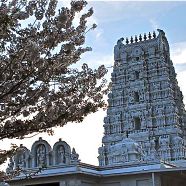





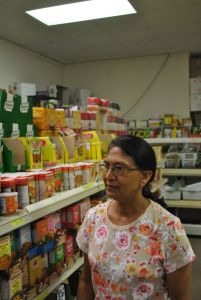
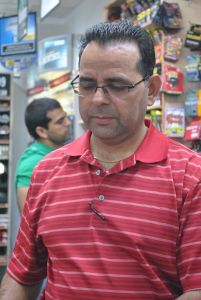
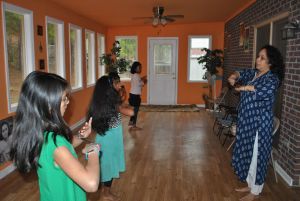
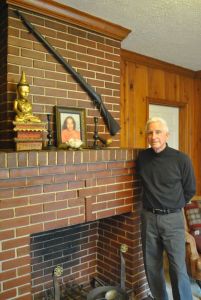
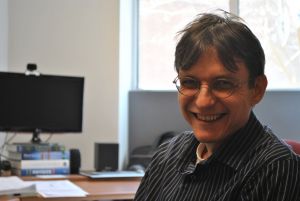
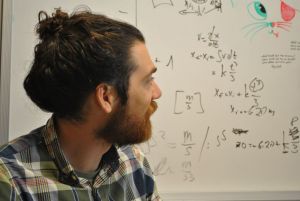
Culturally insightful article and eloquently written! As a current Communication Studies major (who has taken a few interethnic/intercultural classes), this piece complemented my studies via very personal/specific stories that are lived out daily in my very own community.
Thank you, Kim. I appreciate your comments. Yes, indeed, Indians now live across the southern United States, and people do find out that we are mostly good neighbors!
This is a magnificent analysis of a culture that has shaped significantly America’s way of life- for the better. Health care, for one, is practiced more compassionately by Indian born doctors. We are so enriched by their presence and beliefs which emphasize peace and love.
The journey of the Indian in North America so beautifully traced, and its highlights and milestones so well-captured in a very fine story-telling. Thoroughly enjoyed reading. And no, I didnt know about King’s India visit, am going to look that up.
Something which should part of text books about Indians in America.
https://waterfallmagazine.com
Thanks for sharing your thoughts on waterfallmagazine.
Regards